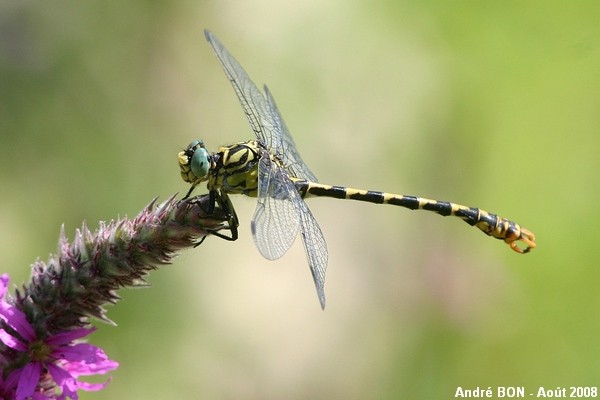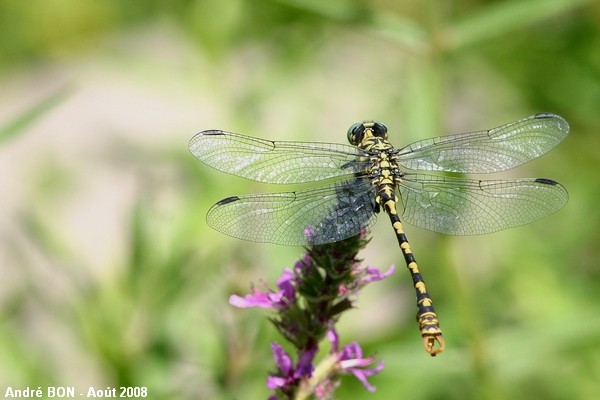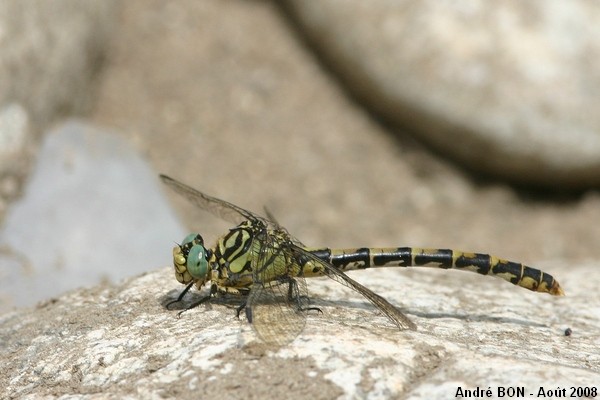


| Green-eyed Hook-tailed Dragonfly (Onychogomphus forcipatus (Linnaeus, 1758)) |



|
|
Scientific name: Onychogomphus forcipatus (Linnaeus, 1758) Common name: Green-eyed Hook-tailed Dragonfly Other names: Small Pincertail French name: Gomphe à pinces, Gomphus à pinces, Onychogomphe à pinces. Order: Odonata Suborder: Anisoptera Family: Gomphidae Wingspan: 55-70 mm. Biotope: Sunny and rocky rivers, sometimes on large lakes with clear water. Geographic area: Europe, missing in the British Isles, in the Netherlands, in northern Germany, in northern Poland and in northern Scandinavia. North Africa, Asia Minor and the Caucasus. Flight time: June to September. |
The Green-eyed Hook-tailed Dragonfly is part of the Gomphidae family which is characterized by widely separated eyes and by a background yellow colour with black marks. Onychogomphus show black spots on the abdomen unlike Gomphus which show black longitudinal stripes. Males' anal appendages look like sugar tongs with three hooks. In the south of France, Green-eyed Hook-tailed Dragonflies live together with Blue-eyed Hook-tailed Dragonflies (Onychogomphus uncatus). You can tell these species apart by having look at the black lines on the side of the thorax. They touch on several points on Blue-eyed Hook-tailed Dragonflies. The anal triangle (veins close to the base of the hind wing) has 3 cells on Green-eyed Hook-tailed Dragonflies (Onychogomphus forcipatus) and 4 on Blue-eyed Hook-tailed Dragonflies (Onychogomphus uncatus). You can also find similar species in Turkey. You can tell them apart with their paler colour and with their pattern lines on the thorax. There are three sub-species Onychogomphus forcipatus forcipatus, Onychogomphus forcipatus unguiculatus and Onychogomphus forcipatus albotibialis. They are very difficult to tell apart and you need to have close look at the hooks for this. Males Green-eyed Hook-tailed Dragonflies are used to landing on rocks near river banks with their abdomen raised upwards. Larvae have a 3-years long development cycle in temperate regions. |
| [To know more about the Green-eyed Hook-tailed Dragonfly] [Next picture] [Top] |

|
This time this Green-eyed Hook-tailed Dragonfly was not landed on a rock. With a flower we get a nicer picture. |
| [To know more about the Green-eyed Hook-tailed Dragonfly] [Next picture] [Previous picture] [Top] |

|
The previous picture shows the patterns on the thorax as a key to tell this dragonfly apart. You can clearly see, on this picture, the three cells of the anal triangle at the base of the hind wing. |
| [To know more about the Green-eyed Hook-tailed Dragonfly] [Previous picture] [Top] |

|
Here is the female without "sugar tongs". I have observed many Green-eyed Hook-tailed Dragonflies on the banks of the Ardèche river and on the banks of its tributaries. One even came to land on my shoe. As my 300mm lenses have a minimal focus distance of 1.5m, my arm (or I would say my leg) was not long enough to be able to take the picture. |